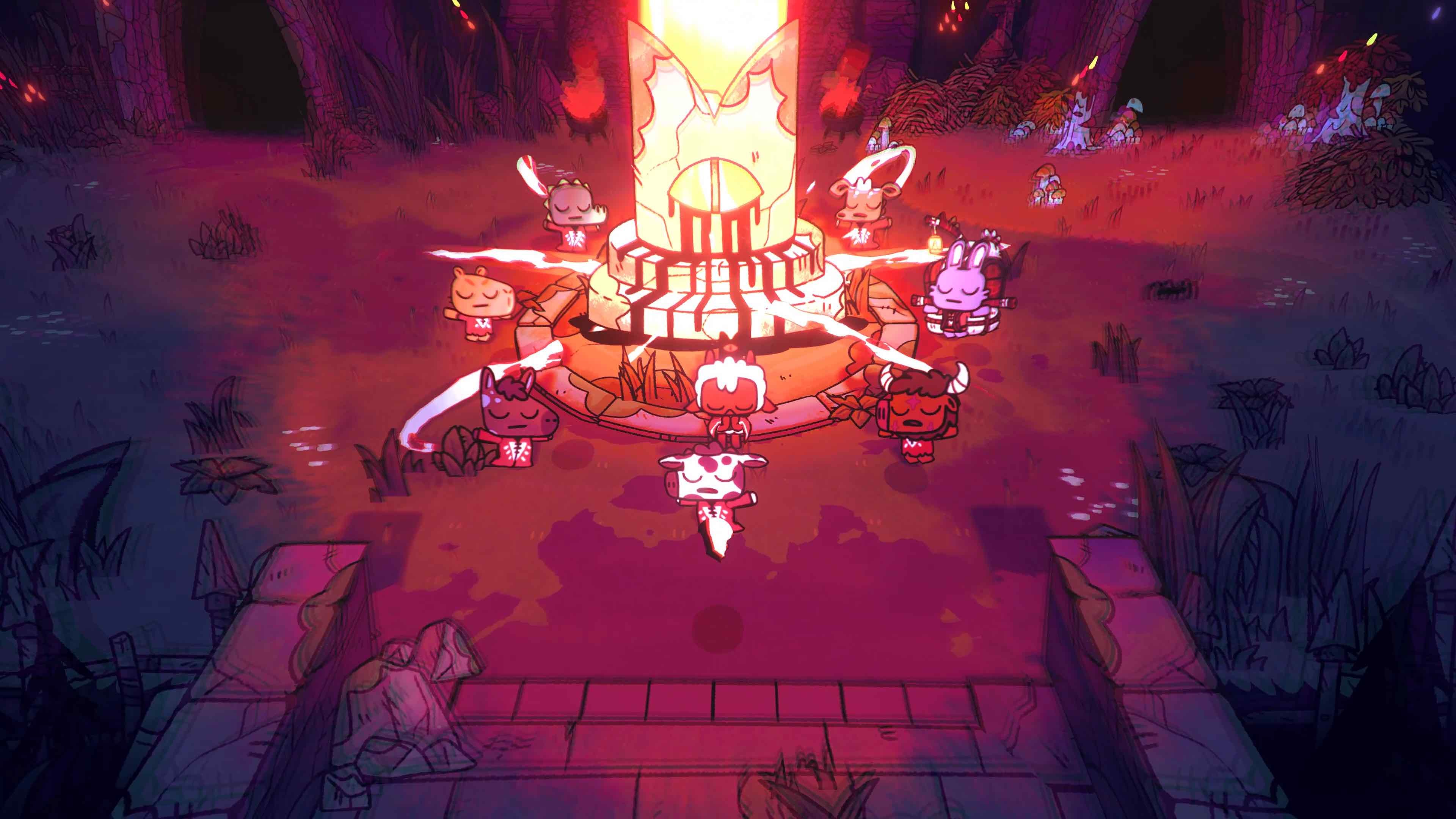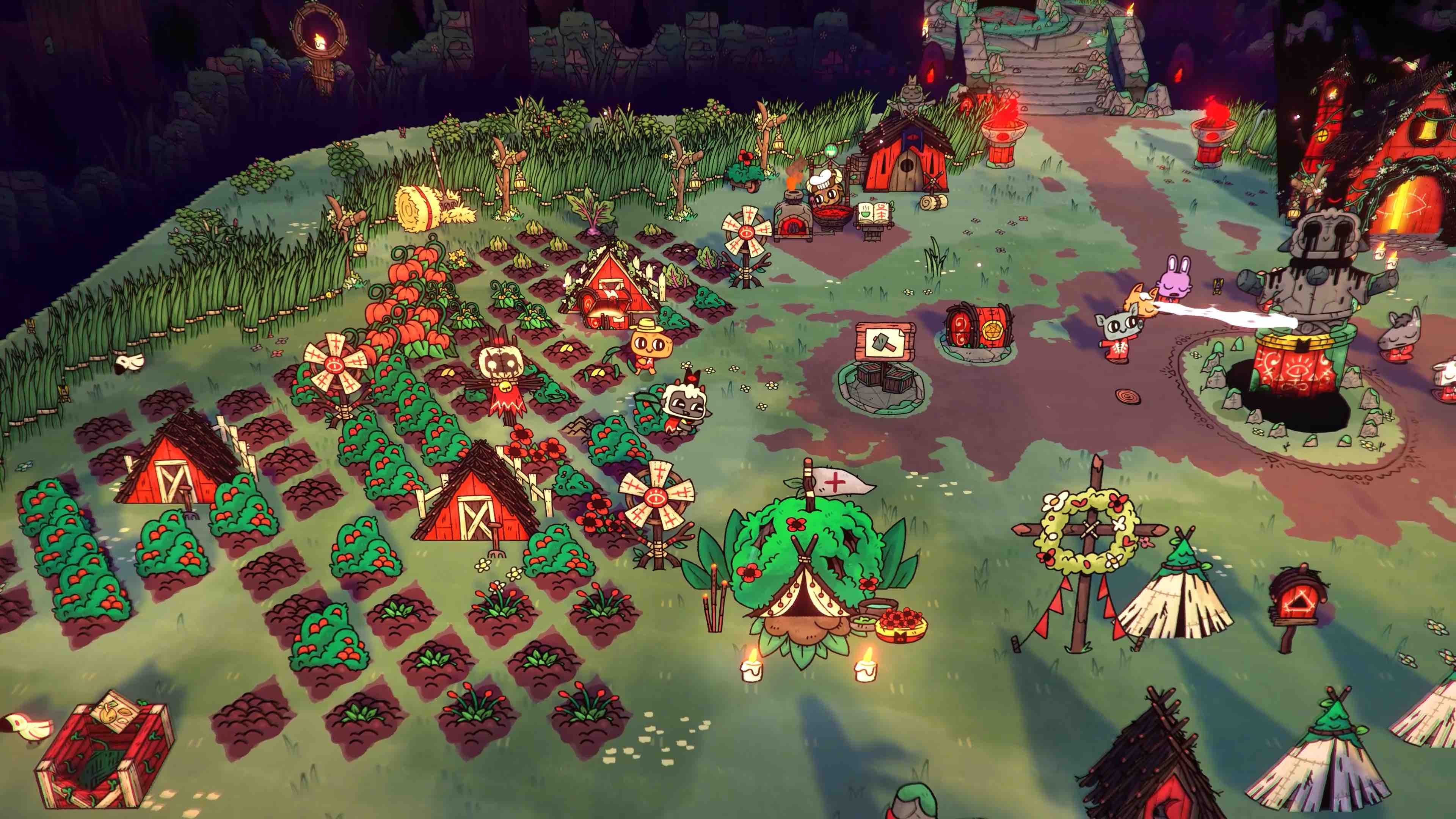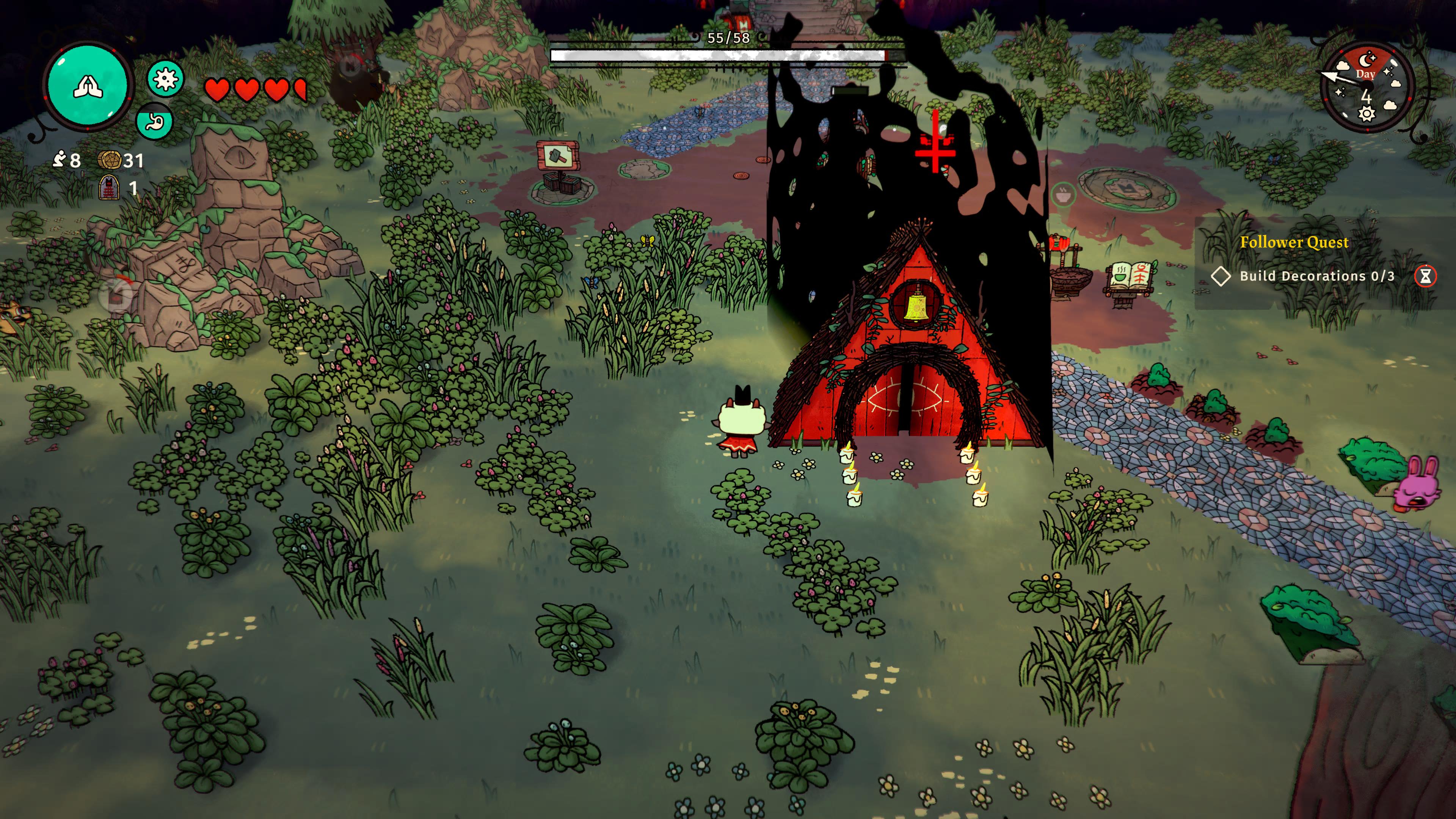Despite what Hollywood may have you think running a cult is tough work — or at least it is in Cult of the Lamb. Out now for consoles and PC, Cult of the Lamb is, depending on who you ask, an action roguelike with city-builder elements or a city-builder with action roguelike elements. Either way, it’s astonishingly top-heavy in terms of how many systems it throws your way from the jump. Despite its cute trappings, the game can get real confusing, real fast. Here are 18 things I wish I knew before starting.
Give both parts of the game equal attention
Cult of the Lamb is largely bifurcated into two sections. There’s the city-building part, where you create structures and tend to various needs of your citizens, all of whom are anthropomorphic animals (and members of your cult). Then there’s the dungeon-crawling part, where you beat up occult-themed enemies on a quest to murder old gods and also find a bunch of resources for your budding town. Don’t think of Cult of the Lamb as one or the other; success is contingent on splitting your time, care, and attention evenly between both sections.
Explore every chamber
It’s the first syllabus item in Roguelikes 101: Explore every single screen before moving on. In Cult of the Lumb, you could find tarot cards, which give you temporary stat-boosting buffs for the duration of your run. You could run into a pedestal that boosts your attack in exchange for health. You might even find a new weapon. All of the stuff is helpful, but really, you’re exploring for one thing: When you’re on a crusade — Cult of the Lamb’s cutesy term for “a run” — your goal is simply to find as many specialist resources, like grass and bones, as possible.
Almost everything turns into resources
The only way you’ll earn as many resources as possible, and of as wide a variety as possible, is by smashing literally everything you see. Patches of tall grass obviously turn into grass, a key resource for most food generation, fertiliser, and even buildings. Crates and barrels could hold gold (used for most crafting recipes). But the inconspicuous stuff is worth breaking too. Skeletons turn into bones, which you can sell or burn for certain rituals (cooldown abilities that offer a huge benefit to your citizens). See a fire pit? You can smash that up to sometimes get some meat, valuable for cooking. Just, uh, don’t think too hard about the morals there.
Dying doesn’t wipe out your haul
Usually, when you die in a roguelike, you lose everything you’ve earned and start from scratch. But in Cult of the Lamb, you’ll retain 75 per cent of the resources you find over the course of a crusade. That said, if you’re lucky, you can stumble upon an upgrade that’ll let you keep everything you’ve found upon death. (This benefit only lasts for one run.) All the more reason to explore every room!

You can’t finish a region in one go
Cult of the Lamb has four regions: the Burton-esque Darkwood, the autumnal Anura, the watery Anchordeep, and the scary AF Silk Cradle. You’ll need to complete multiple crusades throughout each one before you can unlock a run that’ll culminate in the region’s boss. (Also, you need a set number of followers before you can initially access each region. But if you’ve opened up a particular one, and then your flock dips below that requisite, it won’t lock you out. Once you’ve opened up a region, you’re good to go.)
You can turn down the shaking
When you get hit in Cult of the Lamb, the camera shakes. You can tone this down a bit though by opening the settings, going to the accessibility menu, and tweaking the screenshake sensitivity setting. (I’ve found 75 per cent to be the sweet spot where you still see some shake but not so much that it throws you off.) The second option, reduce camera motion, is a toggle, but it smooths things out even more. If you’re getting queasy or finding the visuals at all tough to parse, tweak both of these.
Nab your devotion before starting crusades
At the shrine — that giant pillar in the centre of your town — followers will worship you, filling up your devotion metre. Every time the devotion metre fills up, you can get a divine intervention (aka, unlock a new type of building to construct). Once the shrine is full, though, it can’t store any more. Best to empty it before heading out on a crusade. And in the early levels, at least, it’s typically full again by the time you return from a crusade. Later on, you can put up mini-shrines that can be used as overflow.

Build a farm ASAP
There are a number of meters to keep track of, including faith, which is essentially just the overall happiness of your little community. But the most important thing to keep tabs on is hunger. By creating a farm — an early-level divine intervention — you can automatically ensure you have enough cooking ingredients. Start with the farmer station. That’ll create a small rectangular area, in which you should place a series of farm plots (meant to plant seeds), a scarecrow (prevents birds from stealing your seeds), a seed silo (allows you to store seeds earned on crusades), and a fertiliser silo (where you put your cult’s collective shit). From there, direct one of your followers to “tend farms” and they’ll take care of the planting process automatically.
Note: You still have to manually cook meals, however.
Then build these
After you’ve made a little farm, you’ll want to focus on a number of other helpful divine interventions:
- Outhouse: Once you’ve built an outhouse, your followers should no longer relieve themselves all over your god-given parcel of land.
- Shelter: It’s essentially just an upgrade of the standard sleeping mat, but it falls apart with way less frequency, so you needn’t constantly waste resources (and time, life’s most precious resource) rebuilding things you’ve already built. Less essential. More a matter of convenience.
- Stone mine and lumberyard: You can get a stone of lumber and stone on crusades. But if you make these two buildings, your followers will generate the resources automatically, which allows you to focus on finding other important resources — like grass and bones — while crusading.
- Prison: This is really some stocks, into which you can put a dissenting follower, then “re-educate” them over a couple of days until they worship you properly again.
Grow Camellia as soon as you can
At a certain point you’ll be able to build a medical tent, to which you can send sick acolytes for better treatment than simply bedrest. But to deliver this, you’ll need Camellia flowers. Often as many as 15 for a heal, so you’ll definitely want to make sure they’re growing on your farm whenever possible. You can get the seeds on crusades, or buy them from a worm vendor who’ll eventually show up just outside of town.
Don’t forget your daily activities
Once a day (in in-game time), you’ll be able to perform a sermon from the altar in the temple. There are other follower actions you can perform each day, depending on the rituals you’ve unlocked. You can perform a tithe to earn two pieces of gold from every follower. Or you can inspire to increase their individual level, which begets extra devotion. Make sure you remember to do all of these each day, if you’re not on a crusade. It’s free XP!

Tasks are marked by a black cloud
If there’s something for you to do with a specific structure — the temple, the shrine, a new building, you name it — there’s an easy tell: It’ll be surrounded by an inky black cloud. That means it has a task for you to tend to.
Invest in Sustenance first
As you defeat mini-bosses and build rapport with your cultists, you’ll earn parts of a commandment stone. For every three pieces you earn, you’ll get a full stone and will be able to declare a new doctrine — basically, a rule all of your followers must abide by. There are five categories, all of which are helpful. But the first one you should invest in is Sustenance. That’ll give you the chance to unlock the feast ritual, easily one of the most helpful in the game. Activate it (75 bones, unless you have the cheaper rituals divine inspiration) and you’ll instantly fill up the hunger metre for all of your followers.
Then go into Law and Order
The Law and Order doctrine’s ascend ritual lets you get rid of a dissenting follower — someone who’s lost faith in you as a leader, and is trying to convince the rest of your flock to lose faith too — without falling back on the easy option: killing them. Morality aside here, if other followers see you murdering one of their fellow cultists, they could lose faith, too. But getting rid of a cultist with the ascend ritual not only rids you of your problem, it also boosts the faith of your entire flock.
You’ve gotta commit to doctrines
Every time you issue a new doctrine, you get to choose between two options. The Feast ritual is good for pretty much all situations, but the rest of the choices come down to a matter of playstyle and preference. Just know this: Whichever one you don’t choose ends up gated off. (You can view your doctrines at the altar.)
Fleece of the Fates is the best fleece
After you complete a few side-quests, you’ll earn holy talisman pieces. Get four of those and you can unlock a fleece. When equipped, a fleece will grant you both a buff and a debuff. The best one is the Fleece of the Fates, which starts you off with four tarot cards at the start of your run, but prevents you from finding any more over the course of the crusade. This is a fair trade, if you ask me. You rarely, if ever, end up finding more than four tarot cards in the early game, so the Fleece of the Fates at least guarantees you get the bare minimum. On the flip-side, you don’t get the luxury of adapting this aspect of your builds on the fly — a key strategy for many action-focused roguelikes.
Yes, time still passes while you’re fighting
Time still passes when you’re on a crusade, which means your followers can still age, grow hungry, get sick, and even die. So be mindful that your flock is in good standing before you head into the dungeons. The game will alert you to these events with pop-up notifications, and there’s an unlockable skill that lets you abandon a run to head straight home, if you think it’s an emergency.
Unlock the body pit
You needn’t do it right away, but you should focus on unlocking the body pit in the divine intervention menu. Eventually, probably sooner than you’d expect, some of your followers are going to die. (Old age strikes cultists, too.) If you leave their corpses lying around, they’ll infect the rest of your followers with sickness, which can cause them to die. The solution, then, is to have the option to build a body pit unlocked and ready to go before a wave of death tears through your town, leaving a stream of corpses in its wake. Wait, were you gonna go with the other option? Eating them?? A member of your loyal flock??? You monster!!! (Make sure to pick the doctrine to convince your followers that this is fine — it’s fine — if you do, though.)

Leave a Reply